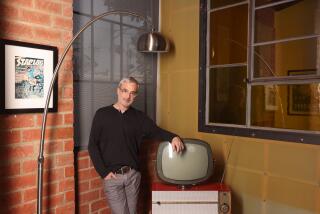Shuttle Offers Dazzling Light Show With Music in Successful Test of Laser Beam
- Share via
HOUSTON — A “Star Wars” missile defense experiment involving the space shuttle Discovery was successfully completed Friday, accompanied by a dazzling light show and a touch of irony--the playing of an overture celebrating a great Russian military victory.
The Discovery’s crew played Tchaikovsky’s “1812 Overture” as a camera aboard the spacecraft captured a wildly fluctuating, vivid beam of blue light transmitted by an Air Force laser station on the Hawaiian island of Maui. The experiment is part of an effort to determine whether the United States can build a space defense against Soviet missiles.
No one at the Johnson Space Center here seemed eager to explain why the crew played the Russian composition, written in 1882 to commemorate the 70th anniversary of Napoleon’s retreat from Moscow.
“The ‘1812 Overture’ is commonly used with laser shows,” said a public affairs officer with the National Aeronautics and Space Administration.
Unexpected Dividends
Whatever the reason for the musical selection, the experiment yielded unexpected dividends in the form of a brilliant light show televised back to Earth from Discovery that would be the envy of many a hard rocker.
It also delighted officials with the Strategic Defense Initiative Organization who carried out the test as a “risk reduction experiment” leading up to more expensive and more complex operations involving lasers and rockets.
“It appears the experiment was a complete success,” said Air Force Lt. Col. Tom Meyer, manager of the ground-based laser program for the “Star Wars” project.
The purpose of Friday’s experiment was relatively simple. Officials wanted to know if they could use the laser to track an object 200 miles above the Earth traveling at 17,400 m.p.h. The laser, reflected back to Maui by a special mirror aboard the shuttle, locked onto the craft and drove the tracking equipment at Maui for “approximately 2 minutes and 30 seconds,” Meyer said, more than twice as long as would have been required for a successful test.
Atmospheric Interference
During that period, the beam was redirected several times to overcome atmospheric interference, accounting for the wild fluctuations in the light.
Meyer said the Earth’s atmosphere “forms what looks like a series of little lenses across the beam. It’s always trying to distort the beam.”
Air turbulence increases the distortion, and for a while Friday it looked as if the experiment would have to be scratched because of high winds at the station atop Haleakala Crater. There also was fear that the winds, which were measured at about 60 m.p.h., could damage the equipment when the astronomical dome covering the tracking system was opened.
Officials decided to proceed, even though the winds “made it a lot more demanding than we had expected,” Meyer said.
He said the results were even better than they had hoped for.
Afterthought for TV
Oddly enough, the brilliant light show was captured for viewers on Earth as an afterthought.
The data that will be analyzed will come from the Maui site, not the photos from the shuttle, and no one had thought to provide televised coverage from the Discovery.
But members of the crew already knew that the laser would offer a great show because they had seen it once before. The experiment was supposed to have been conducted Wednesday, but because of an error on the ground, the shuttle passed over Maui upside down.
Early Friday, the crew asked Mission Control if it had “camera capability.”
The camera was switched on and the show began.
No one, apparently, thought to ask what the crew had in mind for musical accompaniment.
Rendezvous Today
The Discovery was scheduled to rendezvous early today with Spartan, a “free flying” device that was left in orbit Thursday to study galactic centers and the black hole that many astronomers believe lies at the center of our own galaxy, the Milky Way. A black hole is an extremely dense object with gravity forces so great that even light cannot escape.
Spartan, as it is now equipped, uses X-ray astronomy to study those areas and should offer scientists in that field their best view yet. However, scientists who specialize in other areas of astronomy have used a wide range of instruments for many years in the search for understanding of black holes.
Discovery is scheduled to land at 6:14 a.m. Monday at Edwards Air Force Base in Southern California, bringing home a seven-member crew representing three nations.
The crew includes French astronaut Patrick Baudry, 39, and Saudi Arabian Prince Sultan ibn Salman al Saud. The Americans aboard are Daniel C. Brandenstein, 42, the commander; John O. Creighton, 42, the pilot; and Steven R. Nagel, 38; John M. Fabian, 46, and Shannon W. Lucid, 42, all mission specialists.
More to Read
Sign up for Essential California
The most important California stories and recommendations in your inbox every morning.
You may occasionally receive promotional content from the Los Angeles Times.












